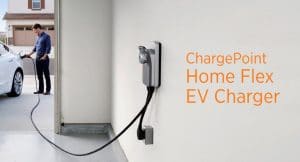
Does your home have enough power to charge an electric vehicle?
The “snowball effect” is every homeowner’s worst nightmare when planning renovations or home upgrades. Hypothetically speaking, this effect happens when a project that was only supposed to cost $100.00 ends up costing $1,000.00. Additional, unforeseen repairs end up making what should have been a simple, inexpensive home upgrade into a complicated and expensive project. This snowball effect can be especially applicable when it comes to installing a charging circuit for a new electric vehicle.
Every home has an electrical system that is designed to provide enough electrical current to support its lighting, appliances, and HVAC system. The component of your electrical system that most accurately defines the “size” of the electrical system is your home’s “service.” The “electric service” includes the meter base on the exterior of the house, the service entrance cable, the electrical panel that contains the circuit breakers, the water pipe bonds and ground rods. The “size” of the service is defined in “Amps”. In Northern Virginia, the most common service sizes can range anywhere from 60 Amps to 600 Amps, with the vast majority being between 150 and 200 Amps. While the size of the service is important to know, it is not the most important factor in determining if your home’s service is big enough to handle the addition of an electric vehicle.
The most important factor in determining if your service can handle the additional load of an electric vehicle charging circuit is the electrical load that your home is placing on the service. Some homes place a relatively small load on the electrical service, and some homes place a relatively large load on the electrical service. Typically, homes that use electricity for heating, hot water, and cooking appliances tend to use a larger percentage of the electrical current available to the service. On the other hand, homes that use natural gas, propane, or oil for heating, hot water, and cooking appliances tend to use a smaller percentage of the current available to the service. This is because generating heat is very inefficient, especially when heating elements, such as the burners on a stove, or the auxiliary heat in a heat pump are used. Homes that use electricity to make heat are more likely to need a larger electrical service to handle the additional loads from an electric vehicle charging circuit.
Since upgrading your home’s electrical service adds significant cost to installing an electric vehicle circuit, you should have an idea of the status of the load on your service before calling an electrician. Engineers and Electricians use a standard load calculation form that is provided for us in the National Electrical Code. However, this form can be fairly confusing for someone who does not regularly work with it. The best way to determine if your home is a good candidate for a service upgrade is to know the size of the service and the type of heating that the house uses. In the field, we typically find that homes having a service of 200 Amps or larger with fossil fuel heat have less of a chance of needing a service upgrade since the gas or oil provides energy for heating. On the other hand, we typically find that homes having a service of 200 Amps or smaller with electric heat have more of a chance of needing a service upgrade, since the energy to create the heat is provided by the electrical service. Load calculations should always be performed by your electrician before adding a large electrical load like an electric vehicle charging system. This is especially true if your home has a service of 200 Amps or less and has electric heat.
If you are looking at purchasing an electric vehicle and are wondering if your house can handle the additional load, or if you already have an electric vehicle and want to install a 50 Amp or 60 Amp Level 2 charging circuit, it is very important to know ahead of time if a service upgrade is needed to install the new charging circuit. The information in this article is designed to provide a quick idea of how much power your electrical system has available. To know for sure, please contact a licensed electrician and have that electrician perform load calculations according to the National Electrical Code. This information will help you plan for the expense of upgrading the electrical service if it is needed.
Real Customers & Real Reviews
Five things to know about your home’s electrical system BEFORE you buy an electric vehicle.
Do you have a driveway or street parking? While this question has less to do with the electrical system itself, it is perhaps the most significant factor in determining if the charging circuit can be installed in the first place. It is significantly less expensive to install an electric vehicle charging circuit at a house with a private driveway or garage. Townhomes or row houses with open spaces or street parking can be very difficult to install a charging circuit for since the charging connector or charging cables can violate ADA (Americans with Disabilities Act) compliance rules for the walkways around or in front of your house. If you do not have a private driveway or garage, research the policy of your county or city, and your homeowner’s association if applicable BEFORE purchasing an electric vehicle.
Does your home have sufficient electrical service capacity? There is an in-depth article on this subject on our website, but here is the quick and dirty: Homes with electric heat have a greater chance of needing to upgrade the electric service capacity to accommodate the addition of an electric vehicle than homes that use fossil fuel for heat. If you have electric heat, make sure your electrician performs load calculations to verify if the service has enough power to carry the new EV charging circuit, or if a larger electrical service is needed.
How old is your electrical panel? The service life of most main electrical panels and circuit breakers is about 30 to 40 years. Adding the load of an electric vehicle charging circuit will place significantly more strain on the components of the electrical system, specifically the buss bars, main lugs, main breaker, and circuit breakers. If your electrical panel is nearing the end of its service life, you should consider replacing it with a new electrical panel and circuit breakers to avoid an unexpected failure.
What brand electrical panel do you have? Some brands of electrical panels are more prone to failure than others. If your home has an electrical panel manufactured by one of the following companies, you should consider replacing it before installing a circuit for an electric vehicle. The brands include: Federal Pacific, Zinsco, GTE-Sylvania, I-T-E Pushmatic, Wadsworth, and Bryant. These panels are typically found in homes built before the 1990’s. Additionally, all fused load centers, (those that use edison-base fuses or cartridge-style fuses) should be replaced before installing an electric vehicle charging circuit.
How far is your main electrical panel from where you plan to park the car? The cost of installing an electric vehicle charging circuit is significantly higher in homes where the electrical panel is far away from the location of the car. Knowing the distance between your electrical panel and your garage or driveway will help you determine if the cost for installing the new circuit will be small, or if you need to sit down before reading your electrician’s estimate.
REQUEST A FREE QUOTE
Satisfaction / Safety First Since 1986




